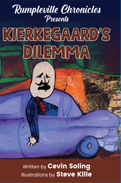
 |
After waking with an axe stuck in his skull, Enrico gets picked up by Estaban. They stop for breakfast on the way to work, and Estaban becomes concerned about the axe. However, before much can be done, Enrico dies. Estaban calls for the check, but the waitress trips and impales him with a knife. Worried about not getting a tip, the waitress runs to tell her boss, who swings open the door, killing the waitress. These fatal accidents continue until a group of girls walking to a parochial school are crushed by a falling man. The nuns with them scold the dead girls for their sloth. Seeing all, God strikes the nuns dead before killing himself, ultimately leaving philosophers completely unsure of what to make of all that has happened. This ending leads the reader back into the story by asking them to reflect on the outcome of those involved, who it all ties to the title, and why it leaves others confused.
Soling opens with Enrico waking with an axe in his head and being perturbed about how it makes showering difficult. This kind of absurdism and sarcasm draws immediate parallels to Kafka’s "Metamorphosis." Depending on the translation, Kafka opens his short story with, “As Gregor Samsa awoke one morning from uneasy dreams, he found himself transformed in his bed into a gigantic insect.” The two share a matching tone of calm and normalcy while being confronted with something fantastic. These play into the existentialism of both Kafka and the title philosopher, Kierkegaard. One of the key components of this philosophy, which seems most relevant here, is the attempt to explain what it means to exist as an individual in a world that cannot be understood. Another interesting aspect is that while many existentialists don’t believe in God, Kierkegaard did. He was more interested in Christianity as a leap of faith than in any attempt at proving its authenticity. Soling includes God at the end of his story and presents him as an all-knowing, all-powerful being who acts in what seems to be an absurd manner, confounding everyone. This leads back to the originally discussed concept of making sense in a world that can’t be understood.
This graphic novel is very short and can be read in a few minutes. The sentences are easy to read and are devoid of mistakes. Some of the illustrations simply portray the action, but several of them are more interesting aesthetically and can stand on their own with a mix of colors, cubism, and a twist on the panel format of comics. There is very little character development in the story, and those who read this work on a more superficial level may wish to, as Kafka writes, “…sleep a little bit longer and forget all this nonsense.” However, others will enjoy making their own discoveries and playing with the ideas hinted at by the author and those who influenced the work. Readers who really dig into the connections between the title, Kierkegaard’s particular set of beliefs, and how this could be interpreted within the context of this concise work will be the ones who get the most from the experience.